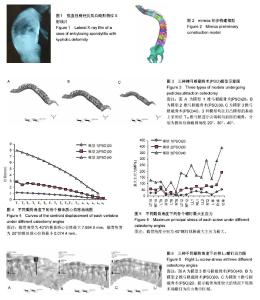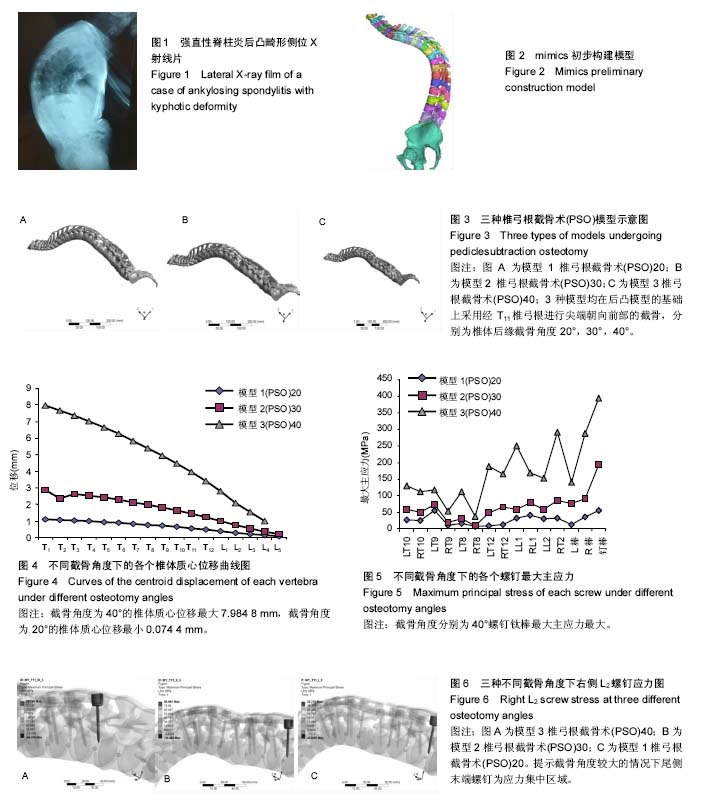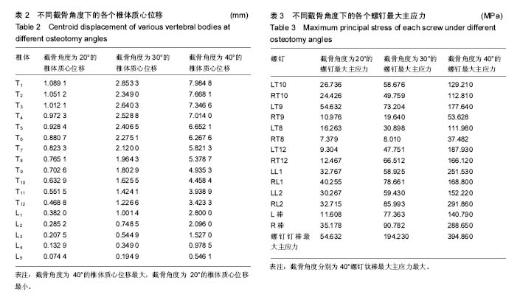| [1] 曾庆馀.风湿病的诊断与治疗最新进展——强直性脊柱炎早期诊断研究进展[J].中国实用内科杂志,2001,21(12): 707-709.[2] 马原,余光宇,王鑫,等.椎板 V 型截骨矫正强直性脊柱后凸畸形的临床效果分析[J].中国矫形外科杂志, 2011,19(23): 1941-1943.[3] 齐鹏,宋凯,张永刚,等.单节段脊柱去松质骨截骨与双节段经椎弓根截骨矫正强直性脊柱炎后凸畸形的临床效果比较[J].中国脊柱脊髓杂志, 2015, 25(9): 775-780.[4] 王岩,毛克亚,张永刚,等.双椎体截骨术矫正重度强直性脊柱炎后凸畸形[J].中国脊柱脊髓杂志,2009,19(2): 108-112.[5] Arlet V. Spinal osteotomy in the presence of massive lumbar epidural scarring.Eur Spine J.2015;24 Suppl 1:S93-106. [6] Hu W, Wang B, Run H, et al. Pedicle subtraction osteotomy and disc resection with cage placement in post-traumatic thoracolumbar kyphosis, a retrospective study.J Orthop Surg Res.2016;11(1):112.[7] Yagi M, Kaneko S, Yato Y, et al. Walking sagittal balance correction by pedicle subtraction osteotomy in adults with fixed sagittal imbalance.Eur Spine J.2016;25(8):2488-2496. [8] 陈雁西,邵志民.数字化骨科临床研究平台的构建及应用[J].中华骨科杂志,2009,29(11): 993-999.[9] 陈羽,宋烜,张海兵.三维重建及虚拟手术在复杂胫骨平台骨折治疗中的应用[J].中国组织工程研究,2013, 17(39):6940-6945.[10] 霍莉峰,倪衡建.数字骨科应用与展望:更精确,个性,直观的未来前景[J].中国组织工程研究,2015,19(9):1457-1462.[11] 步国强,毛仲轩.Mimics 软件模拟置钉在腰椎关节突重度退变椎弓根螺钉内固定中的应用[J].中国组织工程研究,2015,19(17): 2745-2751.[12] 李鹏,梁瑞,申龙朵,等.应用 Mimics 和 ANSYS 软件建立下颌骨三维有限元模型的方法学研究[J].实用口腔医学杂志, 2012, 28(6):709-713.[13] 孔垂雨,张亚军,毋新房,等.便携式关节臂测量机和 Geomagic Studio 在曲面逆向工程中的应用[J].现代制造工程,2013,(9): 35-38.[14] 魏峰. 基于CT图像的人体腰椎有限元模型构建与力学分析[D]. 南京理工大学,2015.[15] 胡辉莹,何忠杰,吕丽萍,等.应用 Mimics 软件辅助重建人体胸廓三维有限元模型的研究[J].解放军医学杂志, 2008, 33(3): 273-275.[16] 覃杰,刘凌云,董云旭,等.320 排 CT 前瞻性和回顾性心电门控冠状动脉成像: 放射剂量, 图像质量及诊断结果的对照观察[J]. 中国医学影像技术,2010,26(5): 951-954.[17] 樊继宏. Mimics 建模到 Marc 有限元分析的系统工程和实例[D].南方医科大学,2010.[18] Behari S,Tungeria A,Jaiswal AK,et al.The" moustache" sign: Localized intervertebral disc fibrosis and panligamentous ossification in ankylosing spondylitis with kyphosis. Neurology India.2010;58(5): 764.[19] Burstein AH, Reilly DT, Martens M. Aging of bone tissue: mechanical properties. J Bone Joint Surg Am.1976;58(1): 82-86. [20] Shirazi-Adl SA,Shrivastava SC,Ahmed AM.Stress Analysis of the Lumbar Disc-Body Unit in Compression A Three-Dimensional Nonlinear Finite Element Study.Spine (Phila Pa 1976).1984;9(2):120-134.[21] Shirazi-Adl A, Ahmed AM, Shrivastava SC.A finite element study of a lumbar motion segment subjected to pure sagittal plane moments.J Biomech.1986;19(4):331-350. [22] 黄宇峰,潘福敏,赵卫东,等.关于腰椎三维有限元模型的建模及有效性验证[J].生物骨科材料与临床研究, 2015,12(5): 16-19.[23] 张宏其,郭超峰,陈凌强,等.Lenke 1 BN 型特发性脊柱侧凸有限元模型的建立及有效性验证[J].中华骨科杂志,2010,30(8): 768-772.[24] 王景丰. 探讨强直性脊柱炎早期临床特点, 早期诊断, 治疗及预后[D]. 天津医科大学, 2012.[25] 赵志明,姚子明,郑国权,等.强直性脊柱炎胸腰段后凸矫形手术近端固定椎的选择[J]. 中国脊柱脊髓杂志, 2016, 26(10): 886-892.[26] 姚子明,郑国权,王征,等.强直性脊柱炎后凸畸形手术相关研究进展[J]. 中国脊柱脊髓杂志, 2016, 26(2): 176-181.[27] 何剑颖 董谢平.脊柱生物力学的有限元法研究进展[J].中国组织工程研究, 2011, 15(26): 4936-4940.[28] 原芳,薛清华,刘伟强.有限元法在脊柱生物力学应用中的新进展[J]. 医用生物力学, 2013, 28(5): 585-590.[29] 刘祥胜. Lenke 2 型特发性脊柱侧凸有限元建模及三维矫形手术的有限元模拟研究[D]. 第二军医大学, 2012.[30] 杨永焱. 脊柱后路单侧融合固定对不同月龄幼兔脊柱生长发育影响的实验研究[D]. 河北医科大学, 2007.[31] 崔轶,李军,陆声,等.激素诱导去势后绵羊骨质疏松动物模型的椎体微观结构观察及力学性能研究[J]. 中国骨质疏松杂志,2016, 22(7): 818-823.[32] 鹿洪辉, 林欣. 颈椎病尸体骨赘模型的设计与建立[J]. 颈腰痛杂志, 2009, 30(2): 103-105.[33] Pavan PG,Pachera P,Forestiero A,et al.Investigation of interaction phenomena between crural fascia and muscles by using a three-dimensional numerical model. Med Biol Eng Comput. 2017;55(9):1683-1691.[34] Alam K, Mitrofanov AV, Silberschmidt VV. Thermal analysis of orthogonal cutting of cortical bone using finite element simulations. International Journal of Experimental and Computational Biomechanics.2010, 1(3): 236-251.[35] 田勇,王阳,夏长丽,等.鹿, 羊和人腰椎形态计量学关联性分析[J]. 吉林大学学报:医学版, 2010,36 (1): 163-168.[36] 赵金柱,袁伟,徐卫东.脊柱关节炎动物模型的研究现状[J].中国骨与关节外科, 2015 ,8(2): 173-176.[37] 焦培峰,常建,杨晓松,等. 基于点信息的人体寰椎三维模型配准[J]. 医用生物力学,2012,27(5):200-205.[38] 凌尚准.腰椎内固定术后翻修原因及对策[J].广西医学,2009, 31(1):122-124.[39] 李家顺,叶晓健,贾连顺,等.腰椎手术失败综合征的原因评价与预防策略[J].中国矫形外科杂志,2001, 8(8): 763-764.[40] Liu X,Yuan S,Tian Y,et al.Expanded eggshell procedure combined with closing-opening technique (a modified vertebral column resection) for the treatment of thoracic and thoracolumbar angular kyphosis.J Neurosurg Spine.2015; 23(1):42-48.[41] Ruo-xian S.强直性脊柱炎后凸畸形矫形修复中截骨方法的进展[J].中国组织工程研究,2012,16(17): 3218-3222.[42] 谢国华,薛峰,杨建平,等.强直性脊柱炎脊柱应力性骨折的诊断[J].中医正骨,2013,24(12): 72-74.[43] 范顺武,刘超,汪银魁,等.椎体后凸成形骨水泥注入对骨质疏松邻近腰椎生物力学的作用[J].中国组织工程研究,2015,19(44): 7177-7181.[44] 宋富立,靳安民,王瑞,等.短节段椎弓根内固定系统术后断裂临床分析[J].中国骨与关节损伤杂志,2005, 20(6): 376-378. |



